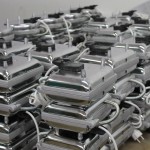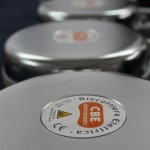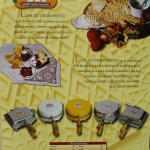Suo padre riparava televisori, ma quando arrivò la Tv a colori dovette cambiare la prima volta pelle e allora si mise a fare accendini a gas era un grande creativo. Durò abbastanza, ma si esaurì anche quella vena e poi Ennio Lauterio si imbatté nei ferri per le pizzelle. Sì, proprio quelli: le piastre di alluminio per fare le neole, o pizzelle, o ferratelle che dir si vogliano. E cominciò in un piccolo laboratorio a Pescara, città natale. Ma la cosa prese piede e allora si spostarono: all’epoca a fare ferri per pizzelle in Abruzzo erano in tanti, studiavano il disegno, sceglievano l’alluminio, lo fondevano e si facevano gli stampi per fare quelli da fuoco e poi quelli elettrici. E così Marco Lauterio, il figlio, divenne fonditore esperto e da quando suo padre Ennio non c’è più porta avanti la sua felice intuizione, perché a fare le biscottiere in Abruzzo è rimasto l’unico.
 Un po’ progettista, un po’ artigiano, un po’ industriale. Noi lo abbiamo scoperto per via della sua voglia di far emergere questa secolare tradizione dolciaria abruzzese. In questi giorni sta facendo realizzare uno spot cinematografico sulla sua attività: “Voglio capire se questo può essere il modo di far decollare le pizzelle e la nostra storia imprenditoriale fuori dall’Abruzzo e anche fuori dall’Italia”. Alle fiere non lo ammettono, perché lo considerano più industriale che artigiano. E questo penalizza anche la sua rivoluzione culturale in nome della tipicità del prodotto che i suoi ferri sfornano. Lo abbiamo raggiunto nella zona industriale di Spoltore, dove la CBE elettrodomestici oggi ha sede e dove Marco fa i forni con i suoi 4 operai e la moglie, Antonietta Di Nucci, crea ricette e idee per utilizzarli al meglio, insieme alla sorella Mirella e all’amica Annarita.
Un po’ progettista, un po’ artigiano, un po’ industriale. Noi lo abbiamo scoperto per via della sua voglia di far emergere questa secolare tradizione dolciaria abruzzese. In questi giorni sta facendo realizzare uno spot cinematografico sulla sua attività: “Voglio capire se questo può essere il modo di far decollare le pizzelle e la nostra storia imprenditoriale fuori dall’Abruzzo e anche fuori dall’Italia”. Alle fiere non lo ammettono, perché lo considerano più industriale che artigiano. E questo penalizza anche la sua rivoluzione culturale in nome della tipicità del prodotto che i suoi ferri sfornano. Lo abbiamo raggiunto nella zona industriale di Spoltore, dove la CBE elettrodomestici oggi ha sede e dove Marco fa i forni con i suoi 4 operai e la moglie, Antonietta Di Nucci, crea ricette e idee per utilizzarli al meglio, insieme alla sorella Mirella e all’amica Annarita.
“Prima fondevamo a Pescara – racconta Marco – Poi, dovendo crescere, io conobbi un signore proprietario di una fonderia, al quale chiesi come fare per perfezionare gli stampi. Era il 1980, ero 18enne quando misi piede per la prima volta nella sua fonderia del bresciano dove lavoravano tantissime operaie. Gli parlai delle mie idee, lui mi disse che ci volevano 100 milioni per fare degli stampi capaci 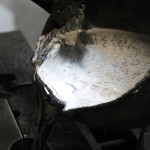
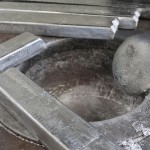 di funzionare. Io tornai a casa sconsolato, e chi ce li aveva 100 milioni?! Quando già lo stavamo per dimenticare lui mi telefonò, mi disse che i miei stampi erano pronti. Ingoiai amarissimo: dovevo trovare quei 100 milioni per pagarli ora. Fortunatamente ci riuscii, grazie alle banche, li comprai e lui mi disse che per imparare ad usarli avrei dovuto pagare la fonderia 500.000 lire al giorno. Bene, imparerò velocemente mi dissi. In un giorno cercai di fissarmi in mente tutto il possibile e poi mi chiusi nella nostra fabbrica e cominciai coi tentativi. Provai e riprovai, imparando dai miei errori e con l’ansia di dover usare quegli stampi acquistati già da qualche anno. E alla fine è andata grazie a Dio”.
di funzionare. Io tornai a casa sconsolato, e chi ce li aveva 100 milioni?! Quando già lo stavamo per dimenticare lui mi telefonò, mi disse che i miei stampi erano pronti. Ingoiai amarissimo: dovevo trovare quei 100 milioni per pagarli ora. Fortunatamente ci riuscii, grazie alle banche, li comprai e lui mi disse che per imparare ad usarli avrei dovuto pagare la fonderia 500.000 lire al giorno. Bene, imparerò velocemente mi dissi. In un giorno cercai di fissarmi in mente tutto il possibile e poi mi chiusi nella nostra fabbrica e cominciai coi tentativi. Provai e riprovai, imparando dai miei errori e con l’ansia di dover usare quegli stampi acquistati già da qualche anno. E alla fine è andata grazie a Dio”.
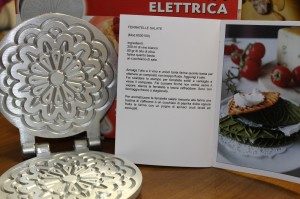 Ora producono materiale di alta qualità, a cui in tanti anni non hanno mai rinunciato, biscottiere in alluminio puro, di quelle che restano. E le esportano, pensate: in media 300 pezzi a settimana per le biscottiere elettriche, più quelli da gas che con gli altri prendono il volo non solo per l’Italia (Piemonte, Val d’Aosta, Molise, Veneto, Lazio, Emilia Romagna oltre all’Abruzzo), ma anche per l’Australia, e la Francia, e l’America. Insieme ad un’altra creazione della CBE: lo Speedygrill. “In pratica è una fornacella per cuocere gli arrosticini che oggi vendiamo anche in alcuni centri
Ora producono materiale di alta qualità, a cui in tanti anni non hanno mai rinunciato, biscottiere in alluminio puro, di quelle che restano. E le esportano, pensate: in media 300 pezzi a settimana per le biscottiere elettriche, più quelli da gas che con gli altri prendono il volo non solo per l’Italia (Piemonte, Val d’Aosta, Molise, Veneto, Lazio, Emilia Romagna oltre all’Abruzzo), ma anche per l’Australia, e la Francia, e l’America. Insieme ad un’altra creazione della CBE: lo Speedygrill. “In pratica è una fornacella per cuocere gli arrosticini che oggi vendiamo anche in alcuni centri
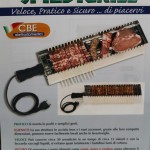 commerciali – spiega Lauterio – ce ne vanno una trentina e cuoce con la resistenza con una tecnica simile a quella della brace, con la differenza che mentre la brace scatena i grassi della carne, la nostra fornacella li cuoce omogeneamente, sfruttando il calore della resistenza. E una volta usata va pure nel lavastoviglie! Ma anche per lanciare questa ce n’è voluto: perché subivamo la concorrenza di quelle in cui gli arrosticini girano, molto più costose. Abbiamo sfondato col prezzo, costa 70 euro e il potenziale di socializzazione che lo Speedygrill si porta dietro”. Nessun premio per l’inventiva, o il valore imprenditoriale.
commerciali – spiega Lauterio – ce ne vanno una trentina e cuoce con la resistenza con una tecnica simile a quella della brace, con la differenza che mentre la brace scatena i grassi della carne, la nostra fornacella li cuoce omogeneamente, sfruttando il calore della resistenza. E una volta usata va pure nel lavastoviglie! Ma anche per lanciare questa ce n’è voluto: perché subivamo la concorrenza di quelle in cui gli arrosticini girano, molto più costose. Abbiamo sfondato col prezzo, costa 70 euro e il potenziale di socializzazione che lo Speedygrill si porta dietro”. Nessun premio per l’inventiva, o il valore imprenditoriale.
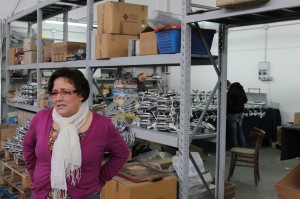 Una lotta continua di resistenza. Non finita, perché ora la sfida è quella di elevare le pizzelle a dignità di eccellenza tipica abruzzese. “Funziona per la piadina, chiediamoci perché non può essere lo stesso per le pizzelle”, dice Antonietta. Lei alle biscottiere dà vita con ricette e idee enogastronomiche davvero fantastiche: pizzelle dolci, salate, colorate, farcite, a strati, per celiaci, persino torte di pizzelle! Per non parlare di quelle che diventano copritazza per cappuccini, porta tovaglioli, cialde e coppette per gelato e macedonie, coni decorativi per buffet, sperimentazioni che fa su La biscottiera elettrica, il blog culinario che tiene con l’amica Annarita Delli Compagni, altra mente vulcanica votata alla causa delle neole.
Una lotta continua di resistenza. Non finita, perché ora la sfida è quella di elevare le pizzelle a dignità di eccellenza tipica abruzzese. “Funziona per la piadina, chiediamoci perché non può essere lo stesso per le pizzelle”, dice Antonietta. Lei alle biscottiere dà vita con ricette e idee enogastronomiche davvero fantastiche: pizzelle dolci, salate, colorate, farcite, a strati, per celiaci, persino torte di pizzelle! Per non parlare di quelle che diventano copritazza per cappuccini, porta tovaglioli, cialde e coppette per gelato e macedonie, coni decorativi per buffet, sperimentazioni che fa su La biscottiera elettrica, il blog culinario che tiene con l’amica Annarita Delli Compagni, altra mente vulcanica votata alla causa delle neole.
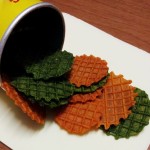 “Con un ferro si può fare davvero di tutto – spiega – persino ostie e crêpes. Le neole, pizzelle continuano ad avere un grande fascino e anche un grande potenziale. Ci sono nella vita di ogni abruzzese, ma non sono mai diventate famose fuori, fa rabbia a pensarci. Noi ci siamo messi in testa di cercare di cambiare le cose e di farle espatriare, così almeno diventano famose da emigranti!” Un tentativo artistico lo hanno fatto i due creativi di Arago Design con la neoletta di porcellana (leggi il nostro articolo), rendendola un’icona della tradizione. La CBE vuole provare a farne una icona del gusto, invece.
“Con un ferro si può fare davvero di tutto – spiega – persino ostie e crêpes. Le neole, pizzelle continuano ad avere un grande fascino e anche un grande potenziale. Ci sono nella vita di ogni abruzzese, ma non sono mai diventate famose fuori, fa rabbia a pensarci. Noi ci siamo messi in testa di cercare di cambiare le cose e di farle espatriare, così almeno diventano famose da emigranti!” Un tentativo artistico lo hanno fatto i due creativi di Arago Design con la neoletta di porcellana (leggi il nostro articolo), rendendola un’icona della tradizione. La CBE vuole provare a farne una icona del gusto, invece.
Lo spot è in fase di lavorazione, porta la firma, fra le altre, di Francesca Ferretti, documentarista made in Abruzzo che per metterlo in piedi ha girato tutto a Pianella, la sua cittadina d’origine, con gente del posto, scenari locali e pizzelle fatte lì coi ferri Cbe. “L’idea è quella di raccontare una tradizione che passa di generazione in generazione e che ci appartiene – ci spiega – non tramonta, quindi è radicata, è l’Abruzzo e deve trovare voce per raccontare le storie che si porta dietro”.
 Già. Storie che sanno di anice. Oppure di uova e farina. Che contengono il rumore del vapore che si propaga nel ferro e allarga la pasta mentre le piastre la schiacciano e la golosità di mangiarle calde, ripiene, a ripetizione o offrirle, scegliendo di farle per passarci il tempo, come avveniva una volta. “Ognuno potrebbe raccontare una storia che sa di pizzelle – dice Antonietta – noi lo facciamo attraverso le ricette. E attraverso i disegni che imprimiamo agli stampi. Quello originario a rombi è antichissimo, nessuno sa dire nemmeno quanto antico, né chi ne
Già. Storie che sanno di anice. Oppure di uova e farina. Che contengono il rumore del vapore che si propaga nel ferro e allarga la pasta mentre le piastre la schiacciano e la golosità di mangiarle calde, ripiene, a ripetizione o offrirle, scegliendo di farle per passarci il tempo, come avveniva una volta. “Ognuno potrebbe raccontare una storia che sa di pizzelle – dice Antonietta – noi lo facciamo attraverso le ricette. E attraverso i disegni che imprimiamo agli stampi. Quello originario a rombi è antichissimo, nessuno sa dire nemmeno quanto antico, né chi ne 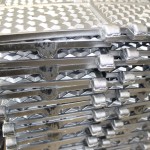
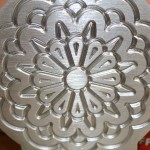 fu l’ideatore. Altri si portano dietro simbologie alchemiche, anche misteriose, oppure folcloristiche, dipende dai disegnatori. Noi siamo affezionati ad un disegno a cui era legato mio suocero, perché è nato mettendo insieme la fantasia di più persone. Quello è il nostro ferro, indicato con un numero, non siamo mai riusciti a dargli un nome, non ancora, ci stiamo pensando”.
fu l’ideatore. Altri si portano dietro simbologie alchemiche, anche misteriose, oppure folcloristiche, dipende dai disegnatori. Noi siamo affezionati ad un disegno a cui era legato mio suocero, perché è nato mettendo insieme la fantasia di più persone. Quello è il nostro ferro, indicato con un numero, non siamo mai riusciti a dargli un nome, non ancora, ci stiamo pensando”.
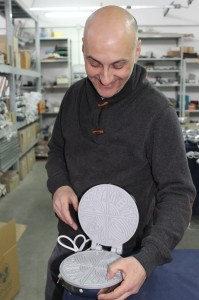 Marco è uno fra i tanti disegnatori che abbiamo in Abruzzo, ma uno dei pochi realizzatori: “Io non solo disegno, ma dò consulenze sul materiale da usare, sul come impostare il lavoro – spiega – perché l’esperienza fatta nella nostra fonderia in più di 30 anni non è solo preziosa, è un vero e proprio patrimonio che dobbiamo mettere a frutto e continuare a far crescere. Non è giusto tenerlo relegato nelle case o nei ricordi di chi è abruzzese soltanto. Ma non è possibile fare sempre tutto da soli. Anche se noi ci stiamo provando. Tante volte sono andato a chiedere alle istituzioni di inserire non la mia azienda, ma le pizzelle, nei disciplinari, nei percorsi di riconoscimento delle eccellenze, dei marchi. Mi hanno sempre guardato obliquamente, perché considerano la mia attività “industriale”. Adesso mi sono
Marco è uno fra i tanti disegnatori che abbiamo in Abruzzo, ma uno dei pochi realizzatori: “Io non solo disegno, ma dò consulenze sul materiale da usare, sul come impostare il lavoro – spiega – perché l’esperienza fatta nella nostra fonderia in più di 30 anni non è solo preziosa, è un vero e proprio patrimonio che dobbiamo mettere a frutto e continuare a far crescere. Non è giusto tenerlo relegato nelle case o nei ricordi di chi è abruzzese soltanto. Ma non è possibile fare sempre tutto da soli. Anche se noi ci stiamo provando. Tante volte sono andato a chiedere alle istituzioni di inserire non la mia azienda, ma le pizzelle, nei disciplinari, nei percorsi di riconoscimento delle eccellenze, dei marchi. Mi hanno sempre guardato obliquamente, perché considerano la mia attività “industriale”. Adesso mi sono 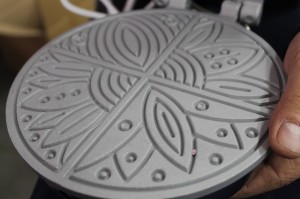 stancato di bussare e voglio provare a vedere se una strada la apro con la forza della qualità di cui sono portatore e che ci ha reso unici in Abruzzo: parteciperemo a fiere nazionali, faremo eventi fuori regione, ma siamo pronti a metterci a disposizione di chi voglia fare con noi questo tentativo. Da perdere non abbiamo niente, l’azienda va. Ma hai visto mai che riusciamo a far diventare le pizzelle abruzzesi finalmente famose nel mondo?”
stancato di bussare e voglio provare a vedere se una strada la apro con la forza della qualità di cui sono portatore e che ci ha reso unici in Abruzzo: parteciperemo a fiere nazionali, faremo eventi fuori regione, ma siamo pronti a metterci a disposizione di chi voglia fare con noi questo tentativo. Da perdere non abbiamo niente, l’azienda va. Ma hai visto mai che riusciamo a far diventare le pizzelle abruzzesi finalmente famose nel mondo?”
(foto Simona Giordano)
[toggle_simple title=”Marco Lauterio’s story, the king of pizzelle (1)”][/toggle_simple]
It all began with his father Ennio Lauterio. He was a TV repairer who had to switch to a new job because of the development of color television, and started manufacturing gas lighters. This lasted quite a long time, but when his creative inspiration dried up he finally shifted his interest to pizzette makers (2) , consisting of two metal plates used to cook the so-called neole, also known as pizzelle, or ferratelle. He initially started with a small factory in Pescara- his birthplace. As the business went really well, Ennio and his family decided to move and expand their company elsewhere. At that time, Abruzzo was full of pizzelle maker manufacturers. They used to choose the best design and used the best aluminum to be transformed into both non-electric and electric pizzelle makers. When Ennio passed away, his son Marco Lauterio made the decision to follow his father’s dream and soon became an expert foundryman. Today, here in Abruzzo, Marco is the only pizzelle maker manufacturer still running an activity in this field.
He is also a designer, a craftsman and an industrialist, and, above all, he singled himself out thanks to his will to keep alive this long-lasting tradition in the confectionery production. He has commissioned a TV commercial to promote his business: “My main purpose is to find out if this is the right way to let both the pizzelle tradition and our Company history be known out of Abruzzo and-why not? out of Italy, too”. The problem is, he is considered more as an enterpreneur than an artisan. Accordingly, he is not usually admitted to most of the art and crafts exhibitions. This could result in a serious obstacle to the “cultural” progress he may bring thanks to the genuine nature of his products.
We met him at the industrial park of Spoltore, where his company (“CBE elettrodomestici”) is located. Marco and his four employees work here as pizzelle makers manufacturers, while his wife Antonietta Di Nucci, her sister Mirella and her friend Annarita constantly come up with new recipes so that their customers can use their pizzelle makers at their best.
“At the beginning we started our business in Pescara”-Marco says- “but at a later stage we decided to move elsewhere. I met the owner of a foundry and I asked him to give me some tips to improve the quality standards of my pizzelle makers. In 1980, when I was only 18 years old, I visited his foundry in Brescia for the first time: I remember plenty of female employees working there. I talked to him about my projects and he told me that the ideal amount of money to have perfectly performing pizzelle makers was 100 million lire (3) . Sadly, I got back home and I was feeling like giving up, because, obviously, I did not have that huge sum of money. I was about to get over it, but one day he called me: my pizzelle makers were ready, and I had to pay them. It was a bitter pill to swallow: I had no choice but to find that sum of money as soon as I could, so I asked for a bank advance. Luckily, I finally managed to buy those pizzelle makers. He also told me that I had to pay him 500.000 lires per day just to learn how to use them. ‘That is fine’- I told to myself- ‘I will learn as fast as I can’. It took me just one day to learn as many things as possible. Soon after that, I got back to my factory and tried to put into practice the skills I had acquired there. Only some years after having bought those pizzelle makers I was finally able to dominate my fear of not being good enough to use them. I worked really hard, I learned from my mistakes and –thanks God- finally, I have made it”.
Currently, they are able to manufacture high-quality standard products, as they never give up on excellence. Their long-lasting pizzelle makers are made of the best aluminum. Recently, they have started exporting them: every week, about 300 electric pizzelle makers (not to count the non-electric ones) are shipped all over Italy (mainly in Piemonte, Val d’Aosta, Molise, Veneto, Lazio, Emilia Romagna-besides Abruzzo, obviously) and overseas, too (France, Australia and United States).
There is also a new entry in the CBE Company: the Speedygrill. “Basically, it is a small barbecue grill used to cook the so-called arrosticini . We even sell it into supermarkets. You can grill about 30 arrosticini (4) at a time with our Speedygrill. It works thanks to an electrical resistance, and it is just like cooking on embers, but the difference is that our Speedygrill does not give you troubles with grease release. Moreover, heat is distributed homogeneously thanks to the electrical resistance. You can put it in the dishwasher, too! Before being able to launch it into the market, we had to fight against those much more expensive rotating grills. A competitive price (70 euros) has been the key to our success, not to count the fact that this cooking technique is quite appealing for our customers, as it’s a good chance to socialize with people around you”. Despite all this, Marco has never been awarded neither for his creativity nor for his entrepreneurial values.
It is a still unfinished fight: the true challenge is to work hard so that pizzelle can be finally known as an excellent product from Abruzzo. “The ‘piadina’ from Romagna has already reached this goal, so why can’t we do the same for pizzelle, then?’” Antonietta says. She has always showed off her “creative” side. She constantly comes out with new, original recipes and unique food ideas: pizzelle with salt, sugar, coloured pizzelle , pizzelle with many types of fillings, multi-layered pizzelle, gluten-free pizzelle, and pizzelle cakes, too! Some more examples are pizzelle used as caps for cappuccino mugs, pizzelle used as napkin holders, pizzelle used as wafer decorations for ice cream, pizzelle used as wafer baskets for ice cream and fruit salads, pizzelle used as buffet table decorations. All these ideas (and many more) have been posted on “La Biscottiera elettrica”, a food blog started by Antonietta and her friend Annarita Delli Compagni, another creative mind sharing with her a common passion for pizzelle.
“You can basically do everything your fantasy suggests with a pizzelle maker- even wafer papers and French crêpes. Pizzelle still hold a special appeal on people and they have great potential. However the problem is that even if they have always been a key element of our tradition, they are not so famous abroad. This is quite frustrating for all of us. We want to try to change this situation, maybe one day we will be famous all around the world!”
Just to give an example, the “Arago Design Company” has already managed to keep the pizzelle tradition alive thanks to the production of pizzelle made of porcelain, thus becoming a cultural symbol of our tradition. CBE Company wants instead to make pizzelle a “gastronomical” symbol.
Their TV commercial is still under production (it was already published, t/n). One of its producers is Francesca Ferretti, a documentary filmmaker from Abruzzo. The whole commercial is set in Pianella, Francesca’s birthplace. The main idea behind this commercial is filming local places and local citizens using CBE pizzelle makers “Our main goal is to talk about a tradition passed down one generation to another”, she explains. “This deep-rooted heritage is part of ourselves, and it seems not to vanish. Abruzzo should find a way to tell these kinds of stories coming from the past”.
These are stories flavored with ansie (5), tasting like eggs and flou (6); they bring with themselves the typical sound coming from a pizzelle maker while you are using it, when the dough is expanding and baking inside the pizzelle iron, just between the two metal plates. You can eat them when they are still warm, with as many filling as creativity suggests you, and it is the ideal snack to offer to your guests; making pizzelle is also a good way to spend your free time, just as our grandmothers did. “Everyone could tell a story somewhat flavored with pizzelle” Antonietta says “and we try to tell this story through both our pizzelle recipes and the large variety of different patterns imprinted on the metal plates. Our diamond pattern is the earliest, but nobody knows neither the exact historical period when it was invented nor its original inventor. Some of them have very specific meanings: according to each pattern designer’s creativity, they have meanings related to alchemy, others may have mysterious connotations, while others may have a folkloristic spirit, too. Particularly, we love the pattern my father-in-law felt himself most emotionally connected to: it was created thanks to the creativity of a group of various people. Look, this is our personal pizzelle maker, we are still looking for the perfect name for it, it is just numbered for now”.
Marco is one of the many draftsman here in Abruzzo, but just one of the few designers: “Besides being a draftsman, I also give recommendations on the best materials and I try to suggest the best approach to the whole manufacturing process. We have more than thirty years’ experience in this field, and we have to treasure all the notions we have acquired throughout these intense years and let them be widely known outside Abruzzo. Although we are doing our best, we know that we cannot do all this by ourselves. I have addressed some institutions in order to let the pizzelle be considered as products with PDO classification, but the problem is that they have never given me a chance as they consider me just as an enterpreneur. However, the choice to use high quality products has paved our way to success: now, we are a unique Company, we are going to take part into national exhibitions, we are planning to organize many events outside Abruzzo. Anyone willing to give a try together with us is welcomed. We do not have anything to lose and the Company is going well for now. Maybe one day we will be able to make our famous pizzelle famous all over the world, too: who knows?” (traduzione Valentina Marinelli)
(1)A typical Italian confectionery similar to waffles. Particularly famous in the Abruzzo region.
(2) A cooking appliance similar to waffle irons.
(3) The official Italian currency before euro.
(4)A traditional dish from Abruzzo mainly consisting of small pieces of lamb meat held together by a thin, sharp wooden stick.
(5) Pizzelle may be sometimes flavored with anise extract.
(6)Two main ingredients for the pizzelle recipe.



